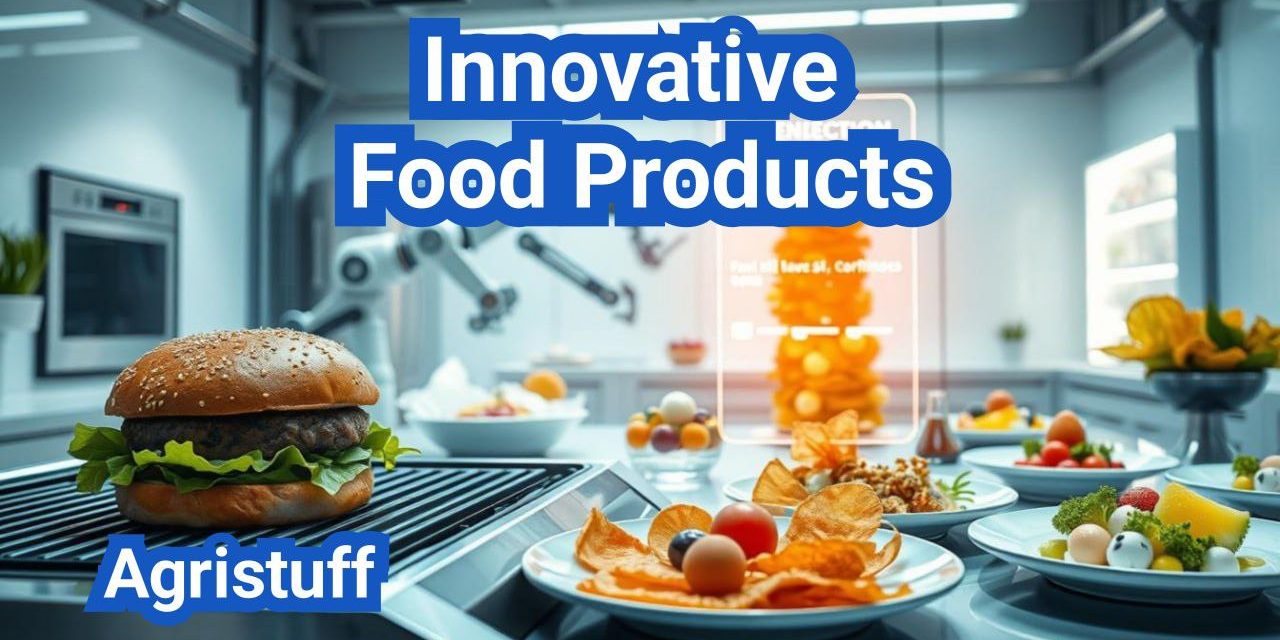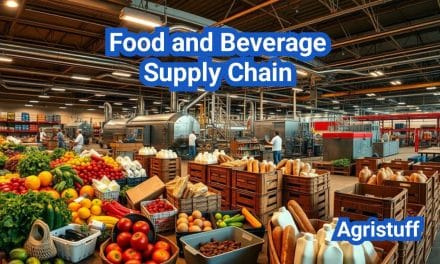The U.S. food industry is constantly evolving, with new trends emerging ( Innovative Food Products ) What’s Winning on U.S. Shelves Right Now and consumer preferences shifting rapidly. To stay ahead, manufacturers are introducing cutting-edge food items that cater to diverse tastes and dietary needs.
The rise of plant-based innovations and subscription food products is transforming the market, offering consumers a wide range of choices. As a result, the demand for food innovation is on the rise, driving growth and competition in the industry.
Key Takeaways
- The U.S. food industry is witnessing a surge in innovative products.
- Plant-based innovations are gaining popularity among consumers.
- Subscription food products are becoming increasingly popular.
- Food manufacturers are focusing on creating cutting-edge food items.
- The demand for food innovation is driving industry growth.
The Evolution of Food Innovation in America
From traditional farming practices to cutting-edge food technologies, America has seen a remarkable journey in food innovation. This evolution has been shaped by historical events, consumer preferences, and technological advancements.
Historical Context of Food Product Development
The history of American food innovation is deeply rooted in its agricultural past. The early 20th century saw the introduction of canned goods, followed by the development of frozen foods. These innovations were driven by the need for longer shelf life and easier transportation. The mid-20th century brought about significant changes with the advent of processed foods, which were designed to be convenient and accessible.
The latter half of the 20th century witnessed a surge in food technology, with the introduction of microwave ovens and ready-to-eat meals. This period also saw the rise of multinational food corporations, which further accelerated the development of new food products.
Key Drivers of Modern Food Innovation
Today, food innovation is driven by a combination of factors, including consumer demand for healthier and more sustainable options, advancements in food technology, and the need for convenience. The rise of e-commerce and social media has also played a significant role in shaping consumer preferences and influencing food trends.
Key drivers include:
- Consumer preferences for healthier and sustainable products
- Technological advancements in food processing and packaging
- The growing demand for convenience foods
- Increased focus on food safety and quality control
The Acceleration of Product Development Cycles
The pace of food innovation has accelerated significantly in recent years, driven by the need to respond quickly to changing consumer preferences and market trends. Companies are now leveraging technologies like AI and data analytics to streamline product development and reduce time-to-market.
This acceleration is also being driven by the increasing complexity of consumer demands, with products needing to be not only tasty and convenient but also sustainable and healthy. As a result, companies are investing heavily in R&D to stay ahead of the curve.
Understanding Today’s Consumer Preferences
The food industry is witnessing a significant shift due to changing consumer preferences. Today’s consumers are more informed, discerning, and demanding than ever before.
Health-Conscious Purchasing Decisions
Consumers are increasingly making health-conscious purchasing decisions, driving demand for products that are not only nutritious but also align with their personal health goals. Clean labeling has become a significant trend, with consumers seeking products with fewer, more recognizable ingredients.
A survey by the International Food Information Council found that 74% of consumers consider “healthy” to be a key factor when making food purchasing decisions. This has led to a surge in products marketed as being high in protein, fiber, or other beneficial nutrients.
Convenience Without Compromise
Convenience remains a top priority for consumers, who are seeking food products that are not only easy to prepare but also meet their health and wellness standards. The rise of meal kits and ready-to-eat meals has been significant, catering to busy lifestyles without compromising on nutrition.
According to a report, the meal kit market is expected to grow significantly, driven by consumer demand for convenience and variety. This trend is pushing manufacturers to innovate in packaging and product development.
Sustainability as a Purchase Driver
Sustainability has emerged as a critical factor influencing consumer purchasing decisions. Consumers are increasingly preferring products and brands that demonstrate a commitment to environmental sustainability and social responsibility.
| Sustainability Factor | Consumer Preference |
|---|---|
| Eco-friendly Packaging | 71% prefer products with minimal packaging |
| Locally Sourced Ingredients | 63% support local farmers and suppliers |
| Carbon Footprint Reduction | 58% are willing to pay more for sustainable products |
Experience-Based Food Consumption
The way consumers experience food is also changing, with a growing interest in unique, experiential food consumption. This includes dining experiences, food festivals, and cooking classes, reflecting a desire to engage more deeply with food.
As consumers continue to evolve in their preferences, the food industry must adapt to meet these changing demands. By understanding and responding to these trends, businesses can stay ahead in a competitive market.
Plant-Based Revolution: Beyond Meat Alternatives

Plant-based products are no longer just alternatives; they’re leading the food innovation wave. The food industry is witnessing a significant transformation as consumers increasingly adopt plant-based diets.
Next-Generation Plant Proteins
The development of next-generation plant proteins is a crucial aspect of this revolution. Innovations in protein sources such as pea, rice, and hemp are providing consumers with diverse options. These proteins are not only used in meat alternatives but are also being incorporated into various food products, enhancing their nutritional profile.
Companies are investing heavily in research to improve the taste, texture, and functionality of these proteins, making them more appealing to a broader audience.
Fermentation-Enabled Innovations
Fermentation-enabled innovations are playing a pivotal role in the plant-based revolution. This technology is being used to create novel ingredients, enhance nutritional content, and improve the sensory attributes of plant-based products.
Fermentation is also being utilized to produce alternative proteins that mimic the taste and texture of animal-derived products, further expanding the plant-based market.
Whole Food Plant-Based Products
The demand for whole food plant-based products is on the rise. Consumers are seeking products that are not only plant-based but also minimally processed and free from additives. This trend is driving the development of products that are closer to their natural state.
Brands are responding by offering a range of whole food plant-based options, from fruits and vegetables to grains and legumes, catering to the growing health-conscious consumer base.
Market Performance of Leading Brands
The market performance of leading brands in the plant-based sector is a testament to the growing consumer demand. Brands that have successfully innovated and adapted to consumer preferences are seeing significant growth.
Market leaders are continuing to expand their product portfolios and distribution channels, making plant-based products more accessible to a wider audience.
Functional Beverages Dominating the Market
Functional beverages are revolutionizing the U.S. beverage market with their innovative formulations. These drinks are not just thirst-quenching but also offer additional health benefits, making them highly appealing to the modern consumer.
Prebiotic Soda Brands Gaining Traction
Prebiotic sodas are emerging as a significant trend within the functional beverage category. Brands are incorporating prebiotics to support gut health, attracting health-conscious consumers.
Key players in this space are focusing on unique flavors and formulations that not only taste good but also provide a health benefit.
Electrolyte Powder Growth Trajectory
Electrolyte powders are witnessing rapid growth, driven by the increasing demand for hydration and performance-enhancing beverages. These products are popular among athletes and fitness enthusiasts.
- Convenience and ease of use
- Customizable hydration levels
- Variety of flavors
Non-Alcoholic RTD Trends
Non-alcoholic ready-to-drink (RTD) beverages are gaining popularity as consumers seek healthier alternatives to alcoholic drinks. These beverages offer the convenience of being ready to consume without the alcohol content.
Market trends indicate a shift towards sophisticated, flavorful drinks that mimic the taste of cocktails without the alcohol.
Functional Beverage Market Expansion in the USA
The functional beverage market in the USA is expanding rapidly, driven by consumer demand for healthier, more functional drinks. This growth is supported by innovation and the introduction of new products.
| Category | 2022 Sales | 2023 Sales | Growth Rate |
|---|---|---|---|
| Prebiotic Soda | $100M | $150M | 50% |
| Electrolyte Powder | $80M | $120M | 50% |
| Non-Alcoholic RTD | $70M | $100M | 43% |
Protein Snacks: The Evolving Landscape

As health consciousness continues to rise, the protein snack segment is evolving with innovative products that cater to diverse consumer needs. The demand for protein-rich foods has led to a surge in the development of protein snacks that are not only nutritious but also delicious and convenient.
Complete Protein Formulations
One of the key trends in the protein snack market is the development of complete protein formulations. These products contain all nine essential amino acids that the human body cannot produce on its own. Brands are incorporating various protein sources such as whey, pea, and rice to create complete protein profiles that support muscle health and satisfaction.
- Multi-source proteins: Combining different protein sources to achieve a complete amino acid profile.
- Plant-based proteins: Increasingly popular among vegan and flexitarian consumers.
Protein Snacks Market Performance in USA
The protein snacks market in the USA has seen significant growth, driven by consumer demand for healthier snacking options. According to market research, the segment is expected to continue its upward trajectory as more consumers prioritize health and wellness.
“The protein snacking category is one of the most dynamic in the food industry, with new products and flavors constantly emerging to meet consumer demand for healthier, more sustainable options.” – Food Industry Expert
Texture and Flavor Innovations
Innovations in texture and flavor are playing a crucial role in the evolution of protein snacks. Manufacturers are experimenting with different textures, such as crunchy, chewy, and smooth, to cater to various consumer preferences. Flavor innovations, including spicy, sweet, and savory options, are also being introduced to enhance the snacking experience.
- Texture variety: Offering a range of textures to appeal to different consumer preferences.
- Global flavors: Incorporating international flavors to add excitement and variety.
Cross-Category Protein Integration
Another significant trend is the integration of protein into traditionally non-protein categories, such as baked goods, confectionery, and even beverages. This cross-category integration is expanding the reach of protein snacks and making them more accessible to a wider audience.
As the protein snack market continues to evolve, it is likely that we will see even more innovative products that combine nutrition, taste, and convenience. The future of protein snacking looks promising, with opportunities for brands to differentiate themselves through unique formulations, flavors, and textures.
Sugar Reduction Technologies Taking Center Stage
As consumers increasingly demand lower sugar products, the food industry is responding with cutting-edge sugar reduction technologies. This shift is driven by growing health consciousness and the need for more natural sweetening alternatives.
Allulose-Based Product Innovations
Allulose, a low-calorie sugar substitute, has gained significant attention for its ability to provide a similar taste and texture to sugar without the calories. Innovative products incorporating allulose are emerging, offering consumers guilt-free alternatives for their favorite treats. For instance, a leading beverage company has launched a line of low-calorie drinks sweetened with allulose, catering to the health-conscious consumer segment.
Monk Fruit and Stevia Advancements
Monk fruit and stevia are natural sweeteners that have been used for centuries but are now being refined and reformulated for modern consumer products. Recent advancements in extraction and blending technologies have improved their taste profiles, making them more appealing to a wider audience. Companies are now combining these sweeteners to create unique blends that offer both sweetness and flavor.
Fiber-Based Sweetening Systems
Fiber-based sweetening systems represent another frontier in sugar reduction. These systems utilize fibers that are naturally sweet or can be made sweet through processing. The benefits include not only reduced sugar content but also an increase in dietary fiber, contributing to the product’s nutritional profile.
Consumer Acceptance of Sugar Alternatives
Consumer acceptance is crucial for the success of sugar alternatives. Education and transparency about the benefits and taste profiles of these alternatives are key. Brands are investing in consumer education initiatives to increase awareness and acceptance of sugar reduction technologies. Successful adoption depends on striking the right balance between health benefits and taste.
The future of sugar reduction looks promising, with ongoing research and development in sweetening technologies. As consumers continue to demand healthier options, the industry is poised to deliver innovative solutions that are both effective and enjoyable.
Frozen Ready Meals: The Premium Revolution

Frozen ready meals have evolved from basic convenience foods to premium culinary experiences. This transformation is driven by consumer demand for higher quality, gourmet flavors, and nutritional improvements in the frozen food aisle.
Chef-Driven Frozen Concepts
The rise of chef-driven frozen concepts is a significant factor in the premium revolution. Celebrity chefs and culinary experts are now partnering with frozen food manufacturers to create sophisticated, restaurant-quality meals. For instance, Home Chef has collaborated with celebrity chef Emeril Lagasse to offer a range of premium frozen meals that boast complex flavors and high-quality ingredients.
Frozen Ready Meals Demand Analysis
Demand for frozen ready meals is on the rise, driven by busy lifestyles and the increasing desire for convenient, yet healthy meal options. According to market research, the frozen ready meals segment is expected to grow significantly in the coming years, with consumers seeking out products that offer both convenience and quality.
“The frozen meals category is experiencing a renaissance, driven by innovative products that cater to the evolving tastes and dietary preferences of consumers.” –
Food Industry Expert
Nutritional Improvements in Frozen Foods
Nutritional improvements are a key aspect of the premium revolution in frozen foods. Manufacturers are now focusing on creating products that are not only delicious but also nutritious. This includes using cleaner ingredients, reducing sodium and sugar, and increasing the protein content of frozen meals. For example, brands like Luvo offer a range of frozen meals that are made with wholesome ingredients and are free from artificial preservatives and flavors.
- Cleaner ingredient profiles
- Reduced sodium and sugar content
- Increased protein content
Packaging Innovations for Premium Positioning
Packaging innovations are also playing a crucial role in the premium positioning of frozen ready meals. Companies are adopting eco-friendly packaging solutions and designing more appealing packaging to differentiate their products on store shelves. For instance, some brands are using biodegradable materials or compostable packaging to reduce their environmental footprint.
As the premium revolution in frozen ready meals continues, consumers can expect to see even more innovative products that combine convenience, quality, and nutrition. With the demand for premium frozen foods on the rise, manufacturers are responding with creative solutions that cater to the evolving needs and preferences of consumers.
Upcycled Ingredients: From Waste to Wow

Upcycled ingredients are revolutionizing the way we think about food waste and sustainability. By transforming what would otherwise be discarded into valuable components, upcycled ingredients are making a significant impact on the food industry.
Certification Standards for Upcycled Ingredients
The upcycled food industry is developing certification standards to ensure the quality and authenticity of upcycled ingredients. Organizations such as the Upcycled Food Association are working to establish guidelines that verify the upcycling process, from sourcing to production.
Key criteria for certification include:
- Sourcing materials that would otherwise be wasted
- Implementing a traceable upcycling process
- Ensuring the quality and safety of the final product
Success Stories in the Upcycled Products Market
Several companies are successfully incorporating upcycled ingredients into their products. For instance, a leading snack food brand is using upcycled vegetables to create healthier snack options.
These success stories demonstrate the potential for upcycled ingredients to not only reduce waste but also to create innovative and appealing products.
Educating Consumers About Upcycled Ingredients
One of the challenges facing the upcycled ingredients market is consumer education. Many consumers are unfamiliar with the concept of upcycling and its benefits.
Effective education strategies include transparent labeling and marketing campaigns that highlight the environmental and nutritional benefits of upcycled products.
Supply Chain Considerations for Upcycled Ingredients
The supply chain for upcycled ingredients requires careful management to ensure a consistent and reliable source of materials.
Companies are developing partnerships with suppliers and implementing robust logistics systems to support the growth of upcycled ingredients.
Innovative Food Products Responding to GLP-1 Trends

With GLP-1 trends on the rise, the demand for healthier, more satisfying food options is increasing. The GLP-1 receptor agonists, used primarily for managing type 2 diabetes and obesity, have led to a shift in consumer behavior towards products that support their health goals.
GLP-1 Grocery Trends Analysis | Innovative Food Products
Recent trends analysis indicates a significant increase in demand for products that cater to consumers using GLP-1 receptor agonists. Grocery trends show a preference for foods that are not only healthy but also support satiety and weight management.
Portion-Controlled Innovation | Innovative Food Products
One of the key innovations in response to GLP-1 trends is portion-controlled packaging. Companies are introducing single-serve sizes and individually wrapped products to help consumers manage their intake effectively.
Examples include: mini snack packs, single-serve ready meals, and portion-controlled beverage containers.
Protein-Forward Formulations | Innovative Food Products
Protein-forward formulations are gaining popularity as they help in satiety and muscle maintenance. Manufacturers are incorporating high-quality protein sources into various products, from snacks to meal replacements.
- High-protein yogurt
- Protein-enriched snack bars
- Lean protein-based ready meals
Satiety-Enhancing Ingredients | Innovative Food Products
The incorporation of satiety-enhancing ingredients is another strategy. Ingredients like fiber, certain healthy fats, and specific proteins are being used to create products that keep consumers fuller for longer.
Examples of satiety-enhancing ingredients include: glucomannan, a type of fiber, and protein sources like whey and casein.
Private Label Innovation: Retailer-Led Product Development

The rise of private label innovation is transforming the retail landscape, driven by retailers who are increasingly taking the lead in product development. This shift is not just about creating generic store-brand products; it’s about crafting unique, high-quality offerings that can compete directly with national brands.
Premium Private Label Strategies | Innovative Food Products
Retailers are adopting premium private label strategies to differentiate their products and attract discerning consumers. This involves investing in high-quality ingredients, sophisticated packaging, and compelling brand storytelling. For instance, some retailers are launching premium organic or non-GMO lines to cater to the growing demand for healthier and more sustainable options.
- Developing unique product offerings that can’t be found elsewhere
- Investing in premium packaging that stands out on shelves
- Creating compelling brand narratives to engage consumers
Exclusive Ingredient Partnerships | Innovative Food Products
To further differentiate their private label products, retailers are forming exclusive ingredient partnerships with suppliers. This allows them to offer unique formulations that are not available in national brands. For example, a retailer might partner with a supplier to create a proprietary blend of spices or a unique type of protein.
Benefits of Exclusive Ingredient Partnerships:
- Unique selling proposition (USP) for private label products
- Enhanced product quality and consistency
- Potential for improved profit margins through exclusive agreements
Design-Forward Packaging | Innovative Food Products
The packaging of private label products is also undergoing a significant transformation. Retailers are investing in design-forward packaging that not only stands out on crowded store shelves but also communicates the quality and value of the product. This includes using premium materials, minimalist design aesthetics, and clear labeling.
Price-to-Value Positioning | Innovative Food Products
One of the key challenges for retailers is positioning their private label products in a way that offers clear value to consumers. This involves balancing quality, price, and perceived value to create an attractive offering. Retailers are using data analytics and consumer feedback to fine-tune their pricing strategies and ensure that their private label products are seen as a smart choice.
By focusing on premium private label strategies, exclusive ingredient partnerships, design-forward packaging, and price-to-value positioning, retailers can successfully drive private label innovation and capture a larger share of the market.
Innovative Food Products for Specific Dietary Needs

The growing demand for specialized nutrition has led to a surge in innovative food products catering to specific dietary needs. Consumers are increasingly looking for products that not only taste good but also meet their dietary requirements, whether it’s for health reasons, lifestyle choices, or personal preferences.
Keto-Friendly Product Expansion | Innovative Food Products
The ketogenic diet has gained popularity for its potential health benefits, leading to an increase in keto-friendly products. Manufacturers are now offering a range of keto-friendly foods, from snacks to meal replacements, that are low in carbohydrates and high in fats.
Low-FODMAP Innovation | Innovative Food Products
For individuals with irritable bowel syndrome (IBS) or those who experience digestive discomfort, low-FODMAP products are becoming increasingly important. Companies are developing products with reduced FODMAPs (Fermentable Oligo-, Di-, Mono-saccharides, and Polyols), making it easier for consumers to manage their symptoms.
Allergen-Free Formulation Advances | Innovative Food Products
Food allergies are a significant concern for many consumers. In response, manufacturers are creating allergen-free products, using alternative ingredients to common allergens like nuts, gluten, and dairy. This not only includes clearly labeled products but also innovative production processes to minimize cross-contamination.
Medical Food Crossover Products | Innovative Food Products
Medical foods are designed for specific dietary needs due to a disease or condition. There’s a growing trend towards crossover products that blur the line between medical foods and conventional foods, making it easier for consumers to manage their health through diet.
| Dietary Need | Innovative Products | Key Ingredients |
|---|---|---|
| Keto Diet | Keto snack bars, low-carb meal replacements | High-fat ingredients, low-carb sweeteners |
| Low-FODMAP | Low-FODMAP bread, pasta, and snacks | FODMAP-reduced ingredients, gluten-free flours |
| Allergen-Free | Nut-free granola, gluten-free baked goods | Alternative grains, nut-free alternatives |
| Medical Foods | Nutritional supplements, disease-specific foods | Specialized nutrients, condition-specific formulations |
In conclusion, the food industry is responding to the diverse needs of consumers by developing innovative products that cater to specific dietary requirements. From keto-friendly and low-FODMAP products to allergen-free and medical food crossover products, the market is becoming increasingly diverse and consumer-friendly.
Culturally-Inspired Innovation: Global Flavors, Local Production

As consumers become more adventurous, the demand for culturally-inspired food products that combine international flavors with local ingredients is on the rise. This trend is driven by the increasing diversity of the U.S. population and a growing interest in global cuisines.
Authentic Ethnic Product Development | Innovative Food Products
The development of authentic ethnic products is a key aspect of culturally-inspired innovation. Food manufacturers are drawing inspiration from various cultures to create products that are both genuine and innovative. For instance, brands are introducing products that reflect the flavors and ingredients of specific ethnic cuisines, such as Korean chili flakes in snack foods or Indian spices in ready meals.
Fusion Food Concepts | Innovative Food Products
Fusion food concepts are another exciting area of culturally-inspired innovation. By combining elements from different culinary traditions, manufacturers can create unique products that appeal to adventurous consumers. Examples include fusion snacks that blend Asian flavors with Latin American ingredients or desserts that combine European techniques with African spices.
“The beauty of fusion cuisine lies in its ability to surprise and delight consumers by bringing together unexpected flavors and ingredients.”
Regional American Cuisine Innovations | Innovative Food Products
Regional American cuisine is also experiencing a resurgence, driven by consumers’ interest in local and artisanal foods. Innovations in this area include products that highlight the unique flavors and ingredients of specific U.S. regions, such as New England clam chowder-flavored soups or Southwestern-style spicy snacks.
Storytelling Through Cultural Food Products | Innovative Food Products
Storytelling is a powerful tool in the marketing of cultural food products. By sharing the origins and cultural significance of their products, manufacturers can create an emotional connection with consumers. This approach not only enhances the product’s appeal but also adds value by preserving cultural heritage.
The trend towards culturally-inspired innovation is expected to continue, driven by consumer demand for diverse and authentic food experiences. As the U.S. food industry continues to evolve, it is likely that we will see even more creative and innovative products that reflect the country’s multicultural identity.
Technology-Enabled Food Innovations

The food industry is on the cusp of a revolution, driven by technology-enabled innovations. These advancements are not only enhancing the way food is produced and consumed but are also opening up new possibilities for sustainability, customization, and nutritional value.
3D Printed Food Applications | Innovative Food Products
3D printing technology is making significant inroads in the food industry, enabling the creation of complex food structures that were previously impossible to achieve. This technology allows for customization of nutritional content, texture, and appearance, catering to individual preferences and dietary needs.
Cellular Agriculture Products | Innovative Food Products
Cellular agriculture, including lab-grown meat, is another area where technology is driving innovation. This method involves cultivating animal cells in a controlled environment, reducing the need for animal slaughter and potentially lowering environmental impact.
AI-Optimized Formulations | Innovative Food Products
Artificial intelligence (AI) is being utilized to optimize food formulations, enhancing taste, nutritional value, and shelf life. AI algorithms can analyze vast amounts of data to predict consumer preferences and suggest improvements.
Smart Packaging Solutions | Innovative Food Products
Smart packaging is integrating technology into packaging to improve food safety, quality, and sustainability. This includes the use of sensors to monitor freshness, indicators for spoilage, and packaging materials that are biodegradable or compostable.
| Innovation | Description | Benefits |
|---|---|---|
| 3D Printed Food | Customizable food structures | Personalized nutrition, unique dining experiences |
| Cellular Agriculture | Lab-grown meat and products | Sustainability, reduced animal slaughter |
| AI-Optimized Formulations | AI-driven recipe development | Enhanced taste, nutrition, and shelf life |
| Smart Packaging | Technology-integrated packaging | Improved safety, quality, and sustainability |
The integration of technology in the food industry is not just a trend; it’s a revolution that is reshaping how we produce, consume, and interact with food. As these technologies continue to evolve, we can expect to see even more innovative applications that enhance the culinary experience.
How to Identify Tomorrow’s Winning Food Innovations
Identifying the next big thing in food innovation requires a deep understanding of current trends and consumer behavior. As the food industry continues to evolve, companies must stay ahead of the curve to remain competitive.
Trend Forecasting Methodologies | Innovative Food Products
Effective trend forecasting involves analyzing consumer data, market research, and social media trends. Companies like PepsiCo and Nestle use advanced analytics to predict emerging trends.
Some key methodologies include:
- Consumer surveys and focus groups
- Social media listening and sentiment analysis
- Market research reports and trend analysis
Early Adoption Indicators | Innovative Food Products
Early adoption indicators are crucial for identifying trends before they become mainstream. These indicators include:
- Increased social media buzz around a particular product or ingredient
- Rising sales figures for products in a specific category
- Innovation in related industries, such as packaging or technology
Cross-Industry Innovation Patterns | Innovative Food Products
Cross-industry innovation often leads to breakthroughs in food technology. For example, the application of 3D printing in food production is revolutionizing the way complex foods are manufactured.
| Innovation | Industry | Application |
|---|---|---|
| 3D Printing | Food Manufacturing | Complex food structures |
| Cellular Agriculture | Meat Alternatives | Sustainable protein sources |
| AI-Optimized Formulations | Food Development | Personalized nutrition |
Consumer Testing Approaches | Innovative Food Products
Consumer testing is a vital step in validating new food innovations. Companies use various methods, including:
- Blind taste tests
- Online surveys and feedback forms
- In-store product demonstrations
By combining these approaches, businesses can refine their products to meet consumer preferences and stay ahead in the competitive food industry.
Implementing Innovative Food Products in Your Business
To thrive in today’s fast-paced food market, businesses need to focus on developing and implementing innovative products. This involves a strategic approach to product development, understanding consumer preferences, and effectively marketing new offerings.
Innovation Pipeline Development | Innovative Food Products
Creating a robust innovation pipeline is essential for sustained success in the food industry. This involves:
- Continuously monitoring consumer trends and preferences
- Investing in research and development to stay ahead of the curve
- Fostering a culture of innovation within the organization
As Jane Smith, a food industry expert, notes, “A well-managed innovation pipeline can be the difference between a company that leads the market and one that follows.”
Balancing Novelty with Familiarity | Innovative Food Products
When introducing new products, it’s crucial to strike a balance between novelty and familiarity. Consumers are drawn to innovative products, but they also value the comfort of familiar tastes and textures.
Successful product launches often combine these elements, creating something new while retaining elements that consumers love.
“The art of innovation lies in understanding how to evolve products in a way that feels both new and familiar to consumers.” –
Food Industry Leader
Scaling Considerations for New Products | Innovative Food Products
Scaling new products from pilot launches to full-scale production requires careful planning. Key considerations include:
| Aspect | Considerations |
|---|---|
| Supply Chain | Ensuring that suppliers can meet increased demand |
| Production Capacity | Scaling manufacturing processes without compromising quality |
| Distribution | Establishing efficient distribution networks |
Marketing Strategies for Innovative Foods
Effective marketing is critical for the success of innovative food products. Strategies include:
- Highlighting the unique features and benefits of new products
- Leveraging social media and influencer partnerships
- Creating engaging in-store promotions
By understanding these strategies and implementing them effectively, businesses can successfully bring innovative food products to market, capturing consumer interest and driving growth.
The Future of Food Innovation in America
The U.S. food industry is on the cusp of a revolution, driven by innovative products that cater to evolving consumer preferences. As we’ve explored, trends such as plant-based alternatives, functional beverages, and sugar reduction technologies are reshaping the market.
The future of food innovation will be characterized by continued advancements in these areas, with a focus on sustainability, health, and convenience. Brands that successfully integrate these elements will thrive in a competitive landscape.
As the industry moves forward, key players will need to stay ahead of the curve by embracing emerging technologies and responding to shifting consumer behaviors. By doing so, they will not only drive growth but also contribute to a more sustainable and diverse food system.
The future of food innovation in America is bright, with opportunities for brands to make a lasting impact on the industry and on consumer tables across the country.
FAQ
What are the key drivers of modern food innovation?
The key drivers of modern food innovation include consumer preferences, technological advancements, and the need for sustainability. These factors have accelerated product development cycles and shaped the industry.
How are consumer preferences influencing food product development?
Consumer preferences are driving the demand for health-conscious purchasing decisions, convenience, sustainability, and experience-based food consumption. These trends are shaping the development of new food products.
What is the significance of the plant-based revolution in the food industry?
The plant-based revolution is significant as it has led to the development of next-generation plant proteins, fermentation-enabled innovations, and whole food plant-based products. This trend is driving growth in the industry.
What are the latest trends in functional beverages?
The latest trends in functional beverages include prebiotic soda brands, electrolyte powder growth, non-alcoholic RTD trends, and the expansion of the functional beverage market in the USA. These trends are driving innovation in the industry.
How are sugar reduction technologies impacting the food industry?
Sugar reduction technologies, such as allulose-based product innovations, monk fruit and stevia advancements, and fiber-based sweetening systems, are enabling the development of healthier food products with reduced sugar content.
What is the role of upcycled ingredients in reducing waste and creating sustainable food products?
Upcycled ingredients are being used to reduce waste and create sustainable food products. Certification standards, success stories, and consumer education are key factors in the adoption of upcycled ingredients.
How are innovative food products responding to GLP-1 trends?
Innovative food products are responding to GLP-1 trends by incorporating portion-controlled innovation, protein-forward formulations, and satiety-enhancing ingredients. These trends are driving the development of healthier food products.
What is the significance of private label innovation in the food industry?
Private label innovation is significant as it enables retailers to drive product innovation and differentiation. Premium private label strategies, exclusive ingredient partnerships, and design-forward packaging are key factors in private label innovation.
How are technology-enabled food innovations transforming the industry?
Technology-enabled food innovations, such as 3D printed food applications, cellular agriculture products, AI-optimized formulations, and smart packaging solutions, are transforming the industry by enabling the development of new and innovative products.
How can businesses identify tomorrow’s winning food innovations?
Businesses can identify tomorrow’s winning food innovations by using trend forecasting methodologies, early adoption indicators, cross-industry innovation patterns, and consumer testing approaches. These strategies enable businesses to stay ahead of the curve.
What are the key strategies for implementing innovative food products in business?
The key strategies for implementing innovative food products in business include innovation pipeline development, balancing novelty with familiarity, scaling considerations, and marketing strategies. These strategies enable businesses to successfully launch and market new products.
Conclusion of: Innovative Food Products In USA
Why “innovative food products” are winning with U.S. shoppers in 2025
Across American grocery aisles, innovative food products succeed when they solve real problems—better nutrition, better value, or better convenience—without sacrificing taste. Consumers keep trading into upgrades that are easy to understand on the label (protein grams, sugar math, fiber sources) and easy to fit into daily routines (RTD, heat-and-eat, air-fryer-ready). That’s why the biggest wins cluster around protein-forward options, functional hydration, lower-sugar sweets, and premiumized private label lines that deliver specialty-store vibes at mainstream prices. IFIC Food & Health Survey
The value equation: private labels as a launchpad for innovative food products
Private brands are no longer just cheaper alternatives—they’re a fast track for innovative food products that pair premium flavors with aggressive pricing. Retailers can test, iterate, and scale what moves, from protein snacks to global-flavor sauces, often beating national brands to shelf with bold formats and clean labels. As shoppers stretch budgets, store brands that feel “discovered” but remain affordable are building loyalty and basket size. PLMA research hub
Proteinization everywhere: the engine behind many innovative food products
From yogurts and puddings to breads, cereals, and chips, high-protein innovative food products are turning up in every aisle. Consumers reward clear protein callouts, especially when they align with satiety and weight-management goals; the best formulas balance macros with flavor so the “healthy” choice still feels indulgent. Expect more ultrafiltered dairy, casein-rich desserts, and multi-protein blends designed for better texture and sustained energy. IFIC on protein attitudes
Gut health goes mainstream inside innovative food products
Digestive wellness has moved from niche to normal, reshaping innovative food products across beverages, snacks, and dairy. Prebiotic fibers (inulin, GOS), fermented bases, and probiotic cultures now appear in everyday formats, not just kombucha or kefir. The winning play: pair tangible function (regularity, comfort) with bright, craveable flavors and transparent CFU or fiber grams on pack. IFIC survey highlights on gut health
Hydration as a lifestyle: powders, sticks, and enhanced waters
Electrolyte powders and enhanced waters have jumped from gym bags into weekly shops, and the most successful innovative food products keep sugar low while dialing up convenience (single-serve sticks, resealable tubs, multipacks). Retailers are expanding cold-box and center-aisle sets to accommodate hydration SKUs that deliver daily, repeatable occasions at accessible price points. Instacart Flavorful Food Forecast
No- and low-alcohol options become celebration-ready innovative food products
American shoppers increasingly seek adult-tasting, occasion-worthy NA choices. Today’s innovative food products include hop waters, RTD mocktails, and de-alcoholized wines that carry culinary flavor cues without the ABV. Category growth invites better merchandising—dedicated “adult NA” sets, cold placement, and seasonal features—so discovery feels premium, not punitive. IWSR no/low outlook
Lower sugar, same pleasure: reformulation that powers innovative food products
Sugar reduction continues to drive trial, so many innovative food products use rare sugars (like allulose), fruit concentrates, fibers, or flavor modulators to deliver indulgence with fewer carbs or calories. Clear labeling matters: allulose’s treatment on Nutrition Facts panels (low calories, not counted as added sugars) enables credible sweetness with better numbers—especially in confectionery, frozen desserts, and beverages. FDA allulose guidance
Upcycled ingredients: sustainability that shoppers can actually buy
“Sustainable” claims resonate most when they’re verifiable, which is why innovative food products featuring Upcycled Certified® ingredients are gaining traction. By turning would-be waste (spent grains, fruit pomace) into tasty snacks and beverages, brands add a concrete environmental benefit that retailers can showcase with signage and filters. The certification provides recognizable shorthand for impact without greenwashing. Upcycled Certified® program
GLP-1 era effects: portioning and satiety in innovative food products
With GLP-1 medications influencing eating routines, the most responsive innovative food products emphasize portion control, protein, and fiber, while trimming prep time. Think smaller cups, high-protein desserts, mini entrées, and satiating snacks that fit new meal cadences. Retailers can lean into “smart portions” displays and macro-forward navigation to help shoppers self-curate. Circana consumer insights
Frozen & heat-and-eat: restaurant-level innovation for weeknights
The freezer door is packed with innovative food products that turn weeknights into “restaurant at home”: globally inspired dumplings, air-fryer sides, protein bowls, and chef-crafted sauces. Success comes from premium flavor plus speed—clear cook times, crisping instructions, and nutritional upgrades that invite trade-up without delivery fees. PLMA category snapshots
Functional beverages: “feel-the-benefit” formats go mainstream
From minerals and adaptogens to caffeine alternatives and prebiotic fibers, functional drinks are now everyday innovative food products—sold in multi-packs and front-of-store coolers. The leaders marry crisp flavors with believable benefits and transparent dosing, then win repeat with reasonable prices and variety. Instacart food & beverage trends
Flavor playbooks: where innovative food products find their edge
Taste remains the ultimate purchase trigger, so innovative food products borrow from restaurants and social food culture: Korean and Filipino sauces, tahini sweets, ube and black sesame desserts, heat-with-nuance chile blends, and layered crunch in snacks. Seasonal and limited-time rotations help retailers keep discovery fresh without rewiring planograms. Whole Foods Top 10 Food Trends 2025
Premium private lines: national-brand quality at mass scale
Retailers increasingly launch premium sub-brands to showcase innovative food products that feel boutique but remain widely available. These lines often carry bolder flavors, cleaner labels, and on-trend formats, helping households “trade up” without leaving their usual store. It’s a distribution advantage that turns trend signals into millions of trial opportunities. Walmart Bettergoods launch
Label clarity & truth-in-claims: the quiet superpower
Consumers reward innovative food products that make benefits legible: exact protein grams, named fiber types, honest sugar accounting, and third-party seals (Organic, Non-GMO, Upcycled). Copy that over-promises or hides details undercuts trust. Teams should align R&D and marketing around what the FDA allows and what shoppers can easily verify on-pack. FDA labeling resources
Merchandising & pack strategy: how innovative food products scale
To grow past novelty, innovative food products need smart sizes (solo, small households), clear occasions (breakfast, snack, post-workout), and discovery-minded placement (endcaps, cross-merch with sauces or sides). U.S. grocer research shows shoppers will try new items that appear credible, convenient, and good-value at first glance. FMI U.S. Grocery Shopper Trends
Plant-forward 2.0: whole-food bases over ultra-processing
The next wave of plant-based innovative food products is shifting toward whole-food recipes (legumes, nuts, mushrooms, vegetables) and simpler ingredient decks. Rather than chasing 1:1 meat mimicry, brands are leaning into naturally satisfying textures and global flavors—delivering “plant-first” experiences that earn repeat on culinary merit. GFI plant-based retail insights
Retailer playbook: spotting the next wave of innovative food products
If you’re scanning shelves for high-potential innovative food products, look for pairs of benefits: protein + portion control; hydration + low sugar; global flavor + weeknight speed; sustainability + price accessibility. Add a credible seal and a Nutrition Facts panel that moves the needle, and you’ve got a stronger shot at repeat purchase and long-term shelf space. PLMA insights for retailers
Final thought
The U.S. shelf is rewarding clarity and credibility like never before. The innovative food products that break out pair obvious taste with obvious benefits—protein and fiber you can see on the panel, hydration you can feel, premium private labels that overdeliver, and sustainability claims with receipts. Nail two or more of those vectors, and you’re not just chasing a trend—you’re building tomorrow’s basket. Read more in IFIC’s consumer survey
Sources & References
- International Food Information Council – 2024 Food & Health Survey
- PLMA – Research & Reports
- Instacart – Flavorful Food Forecast 2025
- IWSR – No/Low Alcohol Outlook
- FDA – Allulose Labeling Guidance
- Upcycled Food Association – Upcycled Certified®
- FDA – Nutrition Facts Label Resources
- FMI – U.S. Grocery Shopper Trends
- Walmart – Bettergoods Launch
- Instacart – Food & Beverage Trends
- Whole Foods Market – 2025 Food Trends
- Good Food Institute – U.S. Plant-Based Retail Insights













